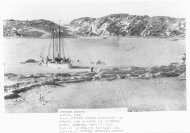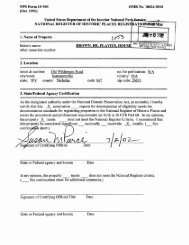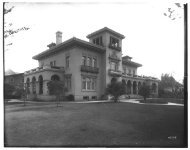National Register of Historic Places Registration Form
National Register of Historic Places Registration Form
National Register of Historic Places Registration Form
You also want an ePaper? Increase the reach of your titles
YUMPU automatically turns print PDFs into web optimized ePapers that Google loves.
NPS <strong>Form</strong> 10-9004 OMB Approval No. 7024-0070<br />
(M6)<br />
United States Department <strong>of</strong> the Interior<br />
<strong>National</strong> Park Service<br />
<strong>National</strong> <strong>Register</strong> <strong>of</strong> <strong>Historic</strong> <strong>Places</strong><br />
Continuation Sheet<br />
CLEVELAND PARK HISTORIC DISTRICT<br />
WASHINGTON D.C.<br />
Section number 7 page 13<br />
brick ornamenting the facade and giving it an Art Deco appearance. Indiana<br />
limestone is used for the more elaborate ornamentation and stone carving which<br />
includes the massive porte cochere with its tympanum <strong>of</strong> pierced stone forming<br />
an abstract lacey pattern, its statues <strong>of</strong> female guardian "angels", and<br />
various friezes with zigzag and floral patterns, the rose panel in the central<br />
tower with its pierced stone created by a zizag pattern, the bas relief<br />
figures struggling to break out <strong>of</strong> the stone panels, the carved peacock panels<br />
(a middle eastern symbol <strong>of</strong> eternal life), and the carved stone rose in a<br />
panel above the stone balcony. The highly decorated copper ro<strong>of</strong> crowning the<br />
central tower accentuates the focal point <strong>of</strong> the complex. Copper is also used<br />
on the opalescent lamps and fan motif below in the porte cochere. Wrought<br />
iron railings along the ro<strong>of</strong>-line parapet add yet another decorative touch and<br />
provide variety as they alternate with the pinnacled stone panels which pierce<br />
the skyline.<br />
The interior is also very elaborate. The lobby itself cost about half a<br />
million dollars. "No expense or attention to detail was spared. More than<br />
two dozen pillars were specially imported from Italy. Each was individually<br />
hand painted, glazed and baked. In the center was a marble fountain stocked<br />
with shimmering goldfish. The reception desk and the lobby furniture was<br />
Grafted from expensive dark stained wood." "(Bill Ivory; "Sedgwick Gardens;"<br />
Trans-Lux; Vol. II, Number 1, March 1984, p.l) "All <strong>of</strong> Sedgwick Gardens' 116<br />
units have sun porches and bay windows. Two baths, considered an incredible<br />
luxury during the 30's, were included in the larger apartments. Promotional<br />
brochures advertised the buildings's air conditioning unit, a complex cooling<br />
system which used pumps to circulate water through the building to carry<br />
unwanted August heat up and out through the ro<strong>of</strong>." *(Ivory, op. cit. p. 2.)<br />
Sedgwick Gardens with its Byzantine and Moorish influence combined with<br />
Art Deco motifs provides a transition from the medieval revival styles <strong>of</strong> the<br />
1920's represented by Tilden Gardens and the Broadmoor to the more explicitly<br />
Art Deco buildings <strong>of</strong> the 1930s represented by the Uptown Theater and the<br />
Macklin Apartments in Cleveland Park.<br />
This apartment building retains its integrity and is a significant<br />
landmark along Connecticut Avenue with its prominent porte cochere and tower<br />
on the corner <strong>of</strong> Connecticut Avenue and Sedgwick Street for all who are<br />
walking or driving along Connecticut Avenue to see. It is a building which<br />
not only addresses the corner - it celebrates it with an extraordinary<br />
exuberance.<br />
*(lvory, op. cit.)<br />
*(Caroline Mesrobian Hickman; "Mihran Mesrobian (1889-1975):<br />
Washington Architect;" Design Action; Vol 2/Number3,<br />
May/June 1983)<br />
*(Hans Wirz and Richard Striner; Washington Deco; Art Deco<br />
in the Nation's Capital; Smithsonian Press, 1984)<br />
*(Goode, op. cit.)<br />
The Macklin <strong>of</strong> 2911 Newark Street was designed by Mihran Mesrobian for<br />
Frank Macklin in 1939 and was built to combine residential units on Newark<br />
Street with a commercial strip along Connecticut Avenue (3400 to 3408). The
















